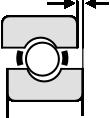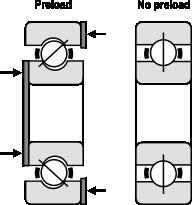Bearing Clearance Data
Bearings Clearance Specs
At first glance, ball bearings are relatively simple mechanisms. However, an analysis of their internal geometries reveals that they are quite complex. For example, the ball to raceway conformity, the radial play, and the number of balls all impact the ability of a ball bearing to support loads under a variety of conditions. Typically, ball and other rolling element bearings are designed and assembled with a slight amount of internal looseness between the rolling elements (balls), and the raceways. This looseness results in both radial play and axial play in the bearing.
Internal clearance or radial play is the amount of looseness between the balls and raceways of a bearing.
For the actual clearances used in the radial play groups, please see RADIAL PLAY TABLES
 |
Radial play is the clearance measured perpendicular to the bearing axis or more specifically: average outer ring raceway diameter minus average inner ring raceway diameter minus (2 x ball diameter). |
 |
Axial play is the clearance measured along the bearing axis is known as axial play. Axial play is approximately 10 times the radial play value. |
The radial play in the bearing before it is fitted can be called the "initial" radial play. "Residual" or "operational" radial play is what is left when the bearing has been fitted. Ideally, there should be zero residual radial play in the bearing to minimize ball skidding and reduce axial play (end play) so correct selection of the initial radial play is important.
A number of things can alter the radial play during the fitting process. A tight shaft fit where the shaft is slightly larger than the bearing inner ring (often called an interference fit or a press fit) will stretch the inner ring so making it bigger. This reduces radial play by up to 80% of the interference fit. A similar thing occurs if the outer ring is a tight fit in the housing. A difference between the shaft and housing temperatures can also be a problem. If a bearing inner ring gets hotter than the outer ring, it will expand more and reduce radial play. This can be calculated as follows:
Chrome Steel: 0.0000125 x (inner ring temp - outer ring temp °C) x outer ring raceway diameter* in mm.
440 Stainless Steel: 0.0000103 x (inner ring temp - outer ring temp °C) x outer ring raceway diameter* in mm.
* The outer ring raceway diameter can be roughly calculated as: 0.2 x (d + 4D) where d is the bore in mm and D is the outer diameter in mm.
There can also be problems where, for example, the shaft is made of different material to the bearing and housing and expands more due to a different expansion coefficient. In such a case, a bearing with a looser radial play may be needed.
A standard radial play is usually suitable and these bearings are more readily available but, sometimes, a non-standard clearance is recommended. A tight radial play is better for low noise, greater rigidity and running accuracy if the load is purely radial. A loose radial play is preferable for high axial loads as it increases the bearing's axial load capacity. It will also better accommodate misalignment between the shaft and housing.
Radial play has nothing to do with precision grade or tolerance. A loose bearing does not necessarily mean a low precision bearing. You can have a P4 (Abec7) grade bearing with a loose radial play just as you can have a P0 (Abec1) bearing with a tight radial play so too much play suggests a tighter radial play or an axial preload is needed.

In low noise or high speed applications, zero residual radial play is desirable. This gives greater rigidity, reduces noise, gives greater running accuracy and can eliminate ball skidding under acceleration. This is achieved by applying a preload to the bearing. This is an axial load applied to the inner or outer ring to offset the outer ring against the inner ring and eliminate radial play.
Preload is usually applied by the use of wave or spring washers and normally to the stationary ring which should have a sliding fit to the shaft or housing to allow for axial movement. If the bearings are glued on to the shaft or housing, it may be possible to use weights to keep the bearing preloaded while the adhesive cures. The amount of preload should be as small as possible. Excessive preload can cause high frictional torque and rapid failure.
Tight Radial Play (MC1/MC2, PO2/P13, C2): Consider for pure radial loads and low noise, low vibration applications. Beware of axial loads, high speed applications, heavy vibration and very low torque applications. Interference fits should not be used.
Medium Radial Play (MC3/MC4, P24/P35, CN): Most commonly used and supplied as standard C0 or no suffix number.
Loose Radial Play (MC5/MC6, P58/P811, C3/C4): Consider for higher axial loads due to greater thrust load capacity. Greater interference fits and shaft misalignment can be tolerated. Also good for heavy or shock loads. Not recommended for low noise applications unless tighter radial play not suitable.
General Design Considerations:
The selection of the radial play value in a specific bearing application is an important design consideration. As described previously, radial play directly affects the contact angle and axial, or end, play of the bearing. In addition, in operation it is an important factor that has a significant influence on other factors such as noise, vibration, heat, stress, deflection, load distribution and fatigue life.
Fitting:
A looser or greater value of radial play should be selected when the bearing is mounted using interference fits. The radial clearance in the bearing is reduced after mounting due to deformation of the inner or outer rings. With miniature bearings having very thin cross section rings, the radial play is reduced by approximately 80% of the actual amount of interference. The radial play after mounting is the primary design consideration. Therefore, a tolerance study of the mating components should be completed and compensation for the interference at maximum material condition must be made. For maximum life, a positive clearance after mounting is desired.
Loading:
When a ball bearing is subjected to thrust loading, a higher contact angle will result in reduced ball to raceway stresses. Greater values of radial play result in higher values of contact angle. Under these conditions, this will provide longer bearing life, lower torque, and less axial deflection. In a pure thrust situation, a 15° increase in contact angle can result in over a 70% reduction in contact stress (ball-to-raceway).
When a ball bearing is subjected to pure radial loads (or radial load with low axial load), lower radial play is normally recommended. This distributes the load over a greater number of balls. However, particularly with miniature bearings, bearings with low radial play should not be subjected to interference fits. This can result in negative clearance and drastically reduce life.
Misalignment and Positioning:
Higher values of radial play allow for greater misalignment and should be selected in cases where there is a high degree of shaft deflection. It should be noted, although a ball bearing has the ability to compensate (around 1° or less), misalignment greatly reduces bearing life. However, in cases with light loads, the impact of minor misalignment may be tolerable.
Tighter values of radial play will of course control and restrict radial movement.
When axial positioning must be controlled or end play of “zero” is desired, it is recommended that the end play be removed by applying axial preload via shims, washers, or other assembly methods. Duplex bearings should be considered as well. It is not advisable to use low values of radial play to control end play.
Temperature:
When a high temperature gradient exists between the inner and outer rings a looser radial play is recommended.
Speed:
As mentioned previously, high values of radial play result in high values of contact angle. When a bearing is rotating, the set of balls (or ball complement) is rotating about the pitch circle of the bearing, each ball is rotating about its own axis, and gyratory moments are acting upon the balls. The magnitude of the gyratory moment is related to the contact angle. As rotational speed increases, the gyratory forces acting on the balls increases and there is sliding action between the balls and the raceways. This slippage results in lubricant film failure, increased heat, and potential premature failure. The balance between the benefits of contact angle reducing stress must be weighed against the potential for lubricant failure due to ball slippage.
